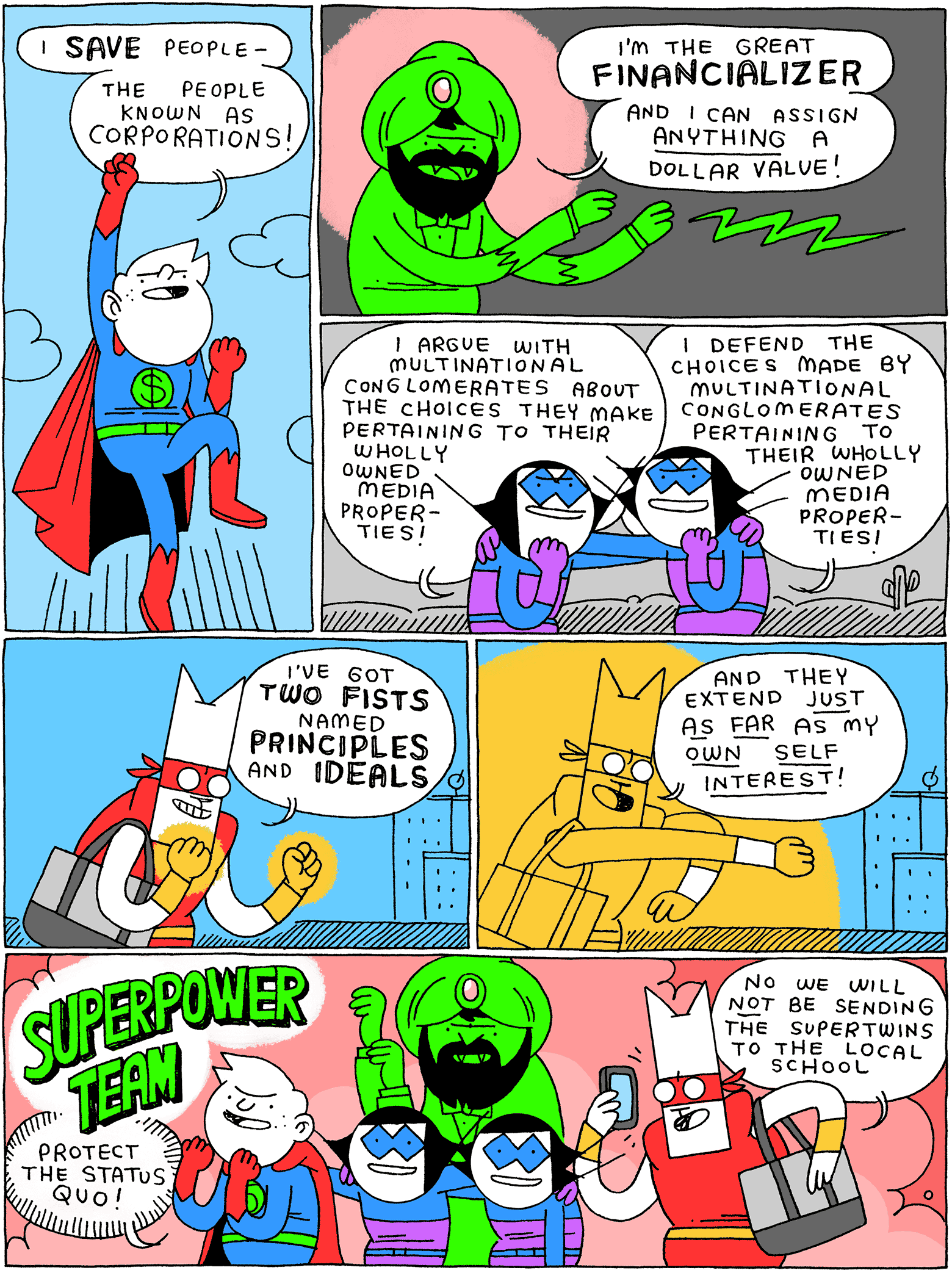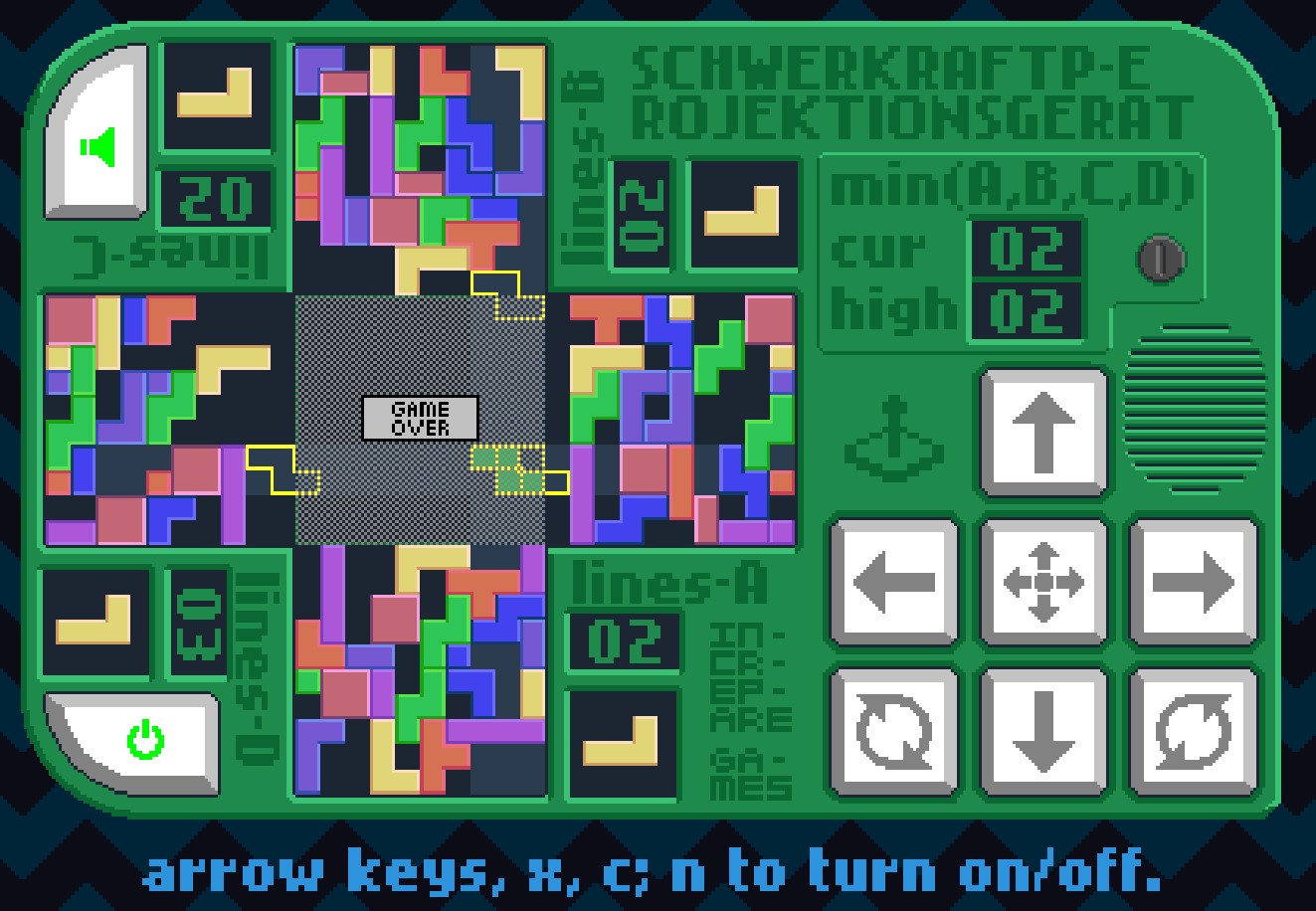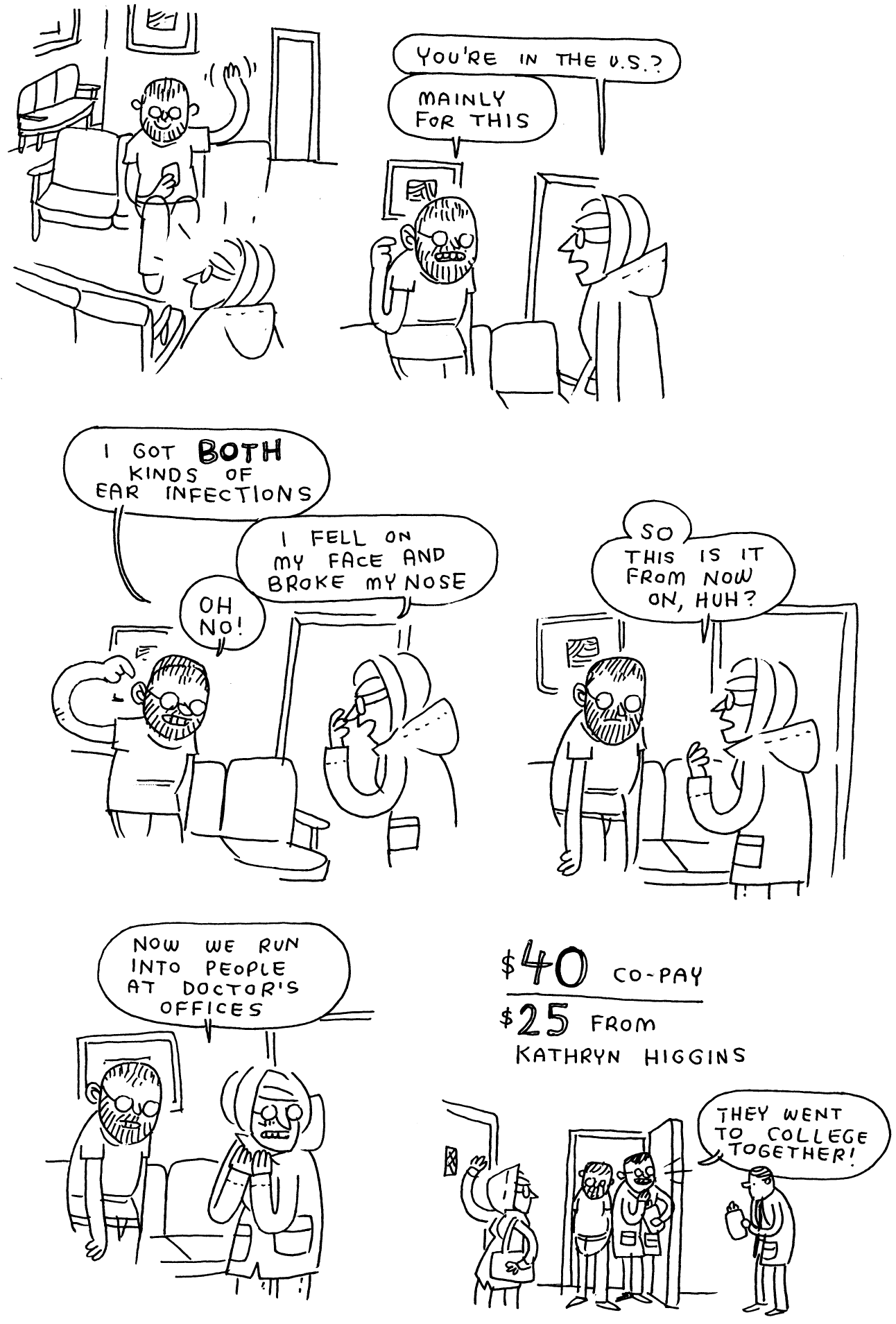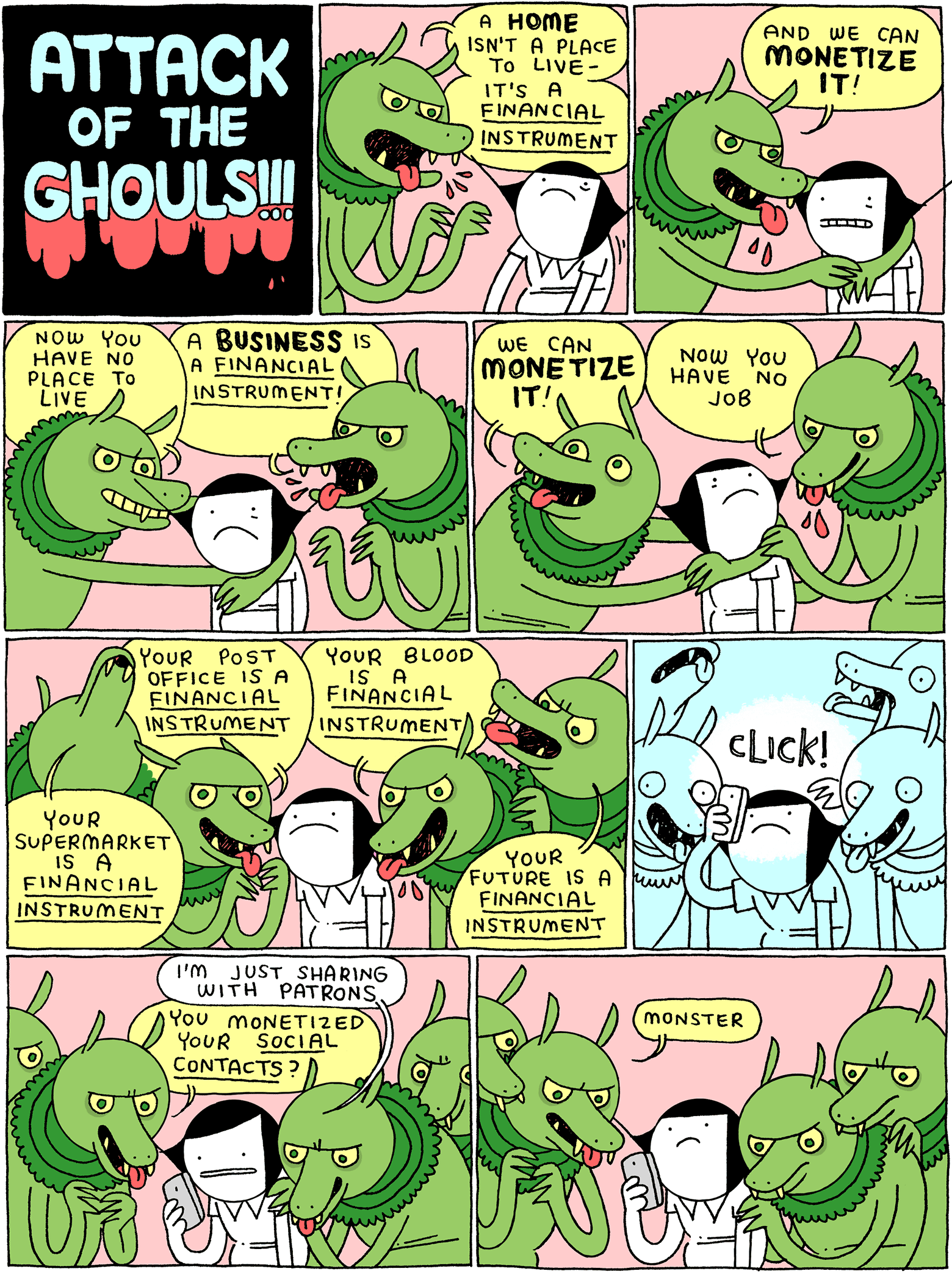
Taylor Swift
Shared posts
SHOCKING REVELATION SATURDAY
Taylor Swift"HARVEY LOST HIS LEG TO JUVENILE DIABETES" is the best Mark Trail twist since the Clown that Couldn't Stop Screaming
Mark Trail, 2/8/20

Oh my god, “Harvey completely made up the story of a yeti ripping his leg off and actually he just had juvenile diabetes” is a so much better ending (?) to this story than I could have possibly imagined. I don’t know what I want more for Monday: Harvey digging his way out of the avalanche and yell-growling “The yeti was a METAPHOR! … a metaphor for JUVENILE DIABETES, my greatest foe!” or just a smash cut back to the cabin in Lost Forest with Mark saying “Yes, Rusty, I did see some unusual animals in Nepal!”
Rex Morgan, M.D., 2/8/20

Oh my god, I had forgotten that June mentioned Aunt Tildy had been married to a man “she called the Count, but he didn’t seem to be rich.” Shoutout to Rex Morgan for surprising me for the first time in literally years: “Andrzej and Tildy are destined to be together” seemed so obviously set up that I entirely missed “Andrzej and Tildy were together once and will be in the future, time is a flat circle, all of this has happened before and will happen again.”
Judge Parker, 2/8/20

Oh my god, what if Sophie decides to not run the campaign of her old family friend but instead puts her considerable political skills to the service of one of his rivals? From what we’ve seen of it, Alan’s campaign is focused on prison abolition and left-leaning NIMBYISM from a perspective of noblesse oblige, and I’m interested to see if his opponent, aided by Sophie’s inside information and all-around smarts, attacks him from the left (“Alan Parker should be put in jail as a class enemy”) or the right (“Alan Parker should be put in jail as an actual criminal, who broke several laws”).
Crock, 2/8/20

Not to be all “poor me” over here, as making fun of comics is something I obviously enjoy and I appreciate getting to earn part of my income from it, but let me just tell you that I read this strip and thought “Huh, I bet conditions on the plantations where they grow pepper are pretty dire, I wonder if there’s some joke to be made out of that,” and ended up opening multiple browser tabs, learning that, for instance, the bottom has fallen out of the Vietnamese pepper market, and that India attempts to protect its native pepper industry with tariffs and price controls but this has led to a a pepper smuggling pipeline from Vietnam via Sri Lanka. Meanwhile, big American companies like McCormick are investing in sustainable pepper operations, at least according to this advertorial “hosted by” The Guardian. I wasn’t really able to mine a lot of laffs out of all that, unless you count the meta-explanation of it I’m doing in this post, but I 100% guarantee that I put a lot more thought into this than was put into this joke.
Barney Google and Snuffy Smith, 2/8/20

The Smifs have lost track of their baby as he crawls through the knee-deep trash that completely covers the floor of their filthy hovel! Ha … ha?
Harajuku Guy w/ Purple Hair in Pink Faux Fur Coat, Plaid Punk Pants & Comme Des Garcons Fashion
Taylor Swift(accidentally peers into my own future)
Soji’s colorful style easily caught our eye on the street in Harajuku.
Soji’s look features a purple hairstyle with white glasses, a pink faux fur coat over a jacket with a rugby necktie, plaid punk pants, and polka dot shoes by the legendary Japanese fashion brand Comme Des Garcons.
Soji’s favorite fashion brand is Comme Des Garcons and he is active on Instagram.




Click on any photo to enlarge it.
Desktop Goose (Sam Chiet)
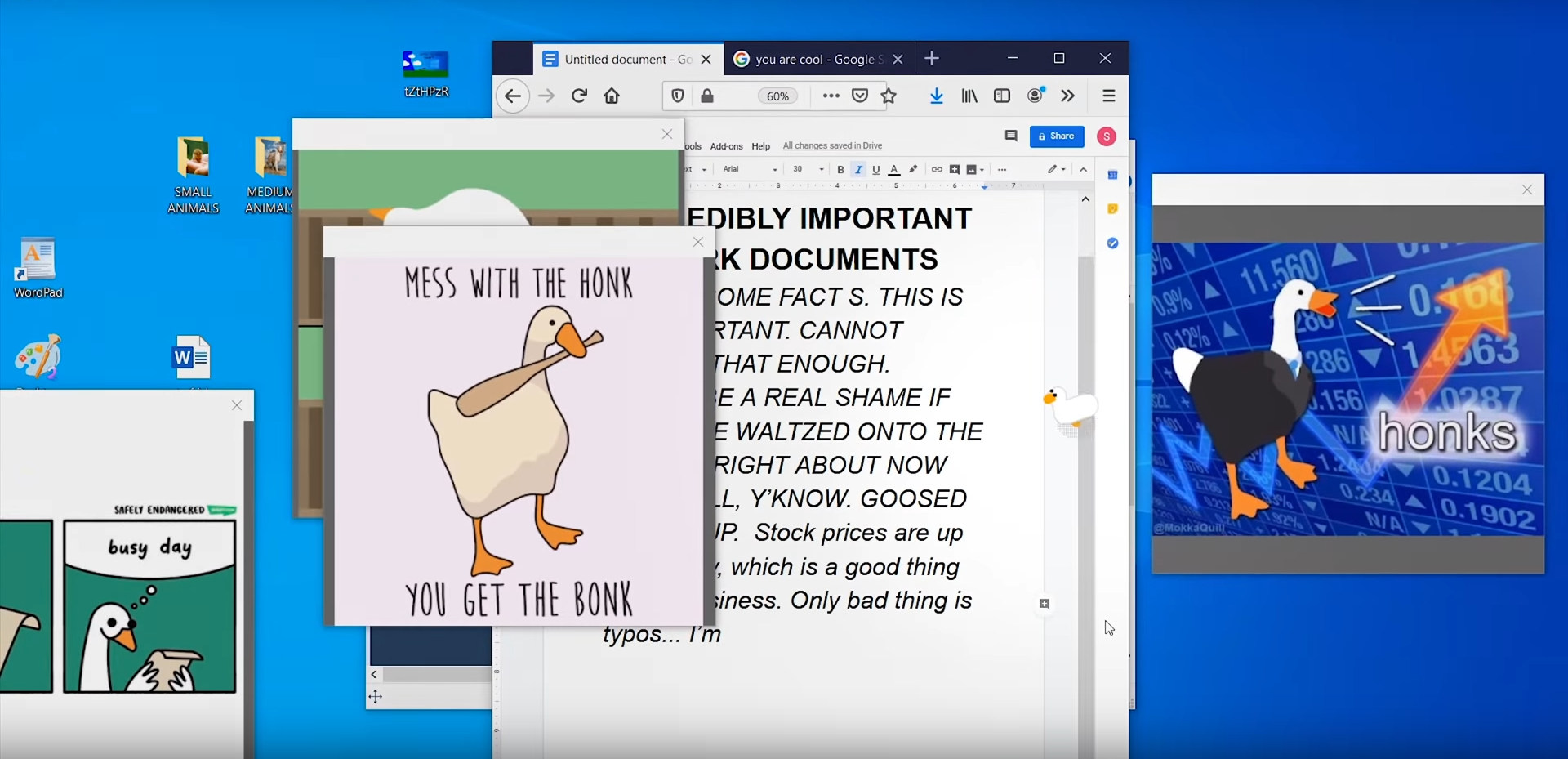
"He'll nab your mouse, track mud on your screen... leave you a message, deliver you memes?" - Author's description
Download on itch.io (Windows)
The Failed State of Massachusetts

The brilliant scholar-activists Steve Striffler and Aviva Chomsky, both of whom teach in Massachusetts and both of whom specialize in Latin American politics and social movements, make the argument that the Bay State is actually a failed state by many measures.
And yet, it is precisely Massachusetts’s wealth and progressive character that makes the failure of government so glaring. Two of the defining features of “failed states”—something typically associated with conflict-ridden countries in the Third World—are the inability to provide public services and the lack of democratic institutions that allow for meaningful citizen participation. In many cases, as in Massachusetts, these two failures are directly connected. The state’s inability to provide core public goods such as transportation, housing, education, and healthcare is a result of a closed political system that serves entrenched interests and undermines the political will of the people. And, here again, Boston is the leader. The city’s unrivaled economic inequality, its reputation for racism, its traffic, and its crumbling system of public education are all tied to state and local institutions that are effectively closed boxes shut off from public input or influence (whether it be the legislature, the Boston Redevelopment Authority, the MBTA, etc.).
This failure has been a long time coming, but its visible manifestations have recently become particularly acute for a simple reason: All of our fundamental public goods and services—transportation, housing, education, and healthcare—are simultaneously in crisis. And crisis in one area tends to compound or expose crisis in others. A crumbling transportation system, for example, puts further stress on already debilitated systems of education, housing, and healthcare. We are in a downward spiral that is making the path out more difficult by the day. What is even more troubling is that despite the clarity of the crisis, our government remains closed off from meaningful popular participation and therefore not only lacks the will and capacity to fund public goods but to pass legislation that addresses the fundamental issues at stake. Massachusetts is a failed state.
Take transportation. Massachusetts political leaders have for decades doubled down on a car-first vision, leaving Boston with the worst traffic in the nation and a system of public transportation that is inadequate, unreliable, out of date, and even unsafe. Failed public transportation, in turn, forces more people into cars and onto roads, intensifying a race to nowhere that has us stuck in place while breathing toxic fumes. It also serves to undermine the state’s limited efforts to combat climate change.
To the extent that we are moving at all, it is in the wrong direction. While other states and cities are confronting transportation crises throughout the nation, Massachusetts political leaders are either missing in action or driving us off the cliff. Gov. Baker and Mayor Walsh have essentially abdicated leadership, in effect opposing efforts to incentivize people to drive less and use public transportation more. Under current conditions, taking the bus, subway, or rail is to run the risk of arriving to work late, getting stranded completely, or falling off the tracks altogether. Political leadership is precisely what is needed if we want to make the changes necessary to make public transportation a realistic option for most people.
On the one hand, congested roads and dysfunctional public transportation serve to raise housing costs in urban areas as people concentrate in certain locales to avoid soul-crushing commutes. On the other hand, outrageous housing costs force working people out of the city and farther from work sites, driving cars they cannot afford greater distances in order to secure rents that allow them to survive. Yet, despite the fact that voters throughout the state consistently point to the housing crisis as the most important issue facing the Commonwealth, politicians have done little to address the problem in any systematic way. Last year Gov. Baker proposed a bill that lawmakers failed to pass because it didn’t go far enough—and so they did nothing.
Mayor Walsh has at times talked a good game and helped create over 30,000 homes with tens of thousands more in the pipeline. But far too few are affordable, and there seems to be little political will to confront the problem or even recognize that government has a responsibility to ensure people are adequately housed. The consequence of inaction—of letting the free market and backroom deals through an old boy network reign—is a development landscape that reproduces inequality through glittery monstrosities such as the Seaport District while forcing more poor people into homelessness. The state’s homeless population jumped 14% in 2018. Working families are struggling to survive as their income is devoured by rent and the dream of home ownership slips away, and even the upwardly mobile are leaving the region for more affordable and transit-friendly locales.
Nor can we take solace in our educational system. To quote a Boston Globe headline, “Beacon Hill lawmakers have been shortchanging the education of students nearly $1 billion a year,” a fact that has disproportionately hurt low-income students, students of color, and recent immigrants. Less than one in three black and Latino fourth graders read at grade level, and only 28% of low-income eighth graders are on grade level in math. This is not entirely surprising. Massachusetts “is no longer among the states that direct more state and local dollars to the districts serving the most low-income students,” and Boston schools are more segregated than they were when the tumultuous process of desegregation tore apart the city decades ago.
Nor are those students likely to catch up if they manage to make their way to the state’s underfunded public colleges and universities. Our political leaders cut funding for higher education by 14% between 2001 and 2017, the cost of which was passed on to students who now leave college with around $30,000 in debt. Average student debt has grown faster in Massachusetts than in all states but one, and the state ranks near the bottom in terms of higher education support per $1,000 of personal income. What that means is that despite being a relatively wealthy state, our political leaders have been very stingy when it comes to funding public higher education. Massachusetts is failing the students of working families at every stage of the educational process, from preschool through college.
One could make similar arguments about California, Oregon, and Washington as well. The rise of these wealthy states and their booming economy has led to some good social policies, but has also led to a lot of selfishness in terms of things such as housing policy, which drives poverty and homelessness. But what about the value of my home!?!?! Indeed, what about the value of your home as homeless people take shelter around the edge of your property. One thing about Latin American and southeast Asian cities where I have been is that it’s not that there’s usually a huge physical distance between the wealthy and the poor masses. It’s that the wealthy are locked in behind gates and fences and security guards and cameras while the poor are just outside. Thinking of the future of the bluest states in a similar light is not a real happy vision. Of course, calling Massachusetts a failed state is meant to be provocative, but it’s also important that you feel provoked by these issues.
Extreme Shoulder Pads Japanese Street Style w/ Handmade Boxy Jacket & Maison Margiela Tabi Boots
Nagi is a 19-year-old Japanese college student we often see around the streets of Harajuku.
Nagi is wearing a super boxy handmade jacket with extreme shoulder pads over a button up shirt, skinny pants, and Maison Margiela tabi boots. His accessories are all from resale shops.
Nagi told us that his favorite fashion brands are the Japanese label Comme Des Garcons and Sulvam. He listens to hip hop music. Follow Nagi on Instagram for more of his street style and fashion life.










Click on any photo to enlarge it.
CWRU2K
Before I tell you this story of January 1st, 2000, I need to back things up a few months into mid-1999. I was working at Case Western Reserve University as a Hypermedia Systems Specialist, which was the closest the university’s job title patterns could get to my actual job which was, no irony or shade, campus Webmaster. I was in charge of www.cwru.edu and providing support to departments who wanted a Web presence on our server, among many other things. My fellow Digital Media Services employees provided similar support for other library and university systems.
So in mid-1999, we were deep in the throes of Y2K certification. The young’uns in the audience won’t remember this, but to avoid loss of data and services when the year rolled from 1999 to 2000, pretty much the entire computer industry was engaged in a deep audit of every computer and program under our care. There’s really been nothing quite like it, before or since, but the job got done. In fact, it got done so well, barely anything adverse happened and some misguided people now think it was all a hoax designed to extract hefty consulting fees, instead of the successful global preventative effort it actually was.
As for us, pretty much everything on the Web side was fine. And then, in the middle of one of our staff meetings about Y2K certification, John Sully said something to the effect of, “Wouldn’t it be funny if the Web server suddenly thought it was 1900 and you had to use a telegraph to connect to it?”
We all laughed and riffed on the concept for a bit and then went back to Serious Work Topics, but the idea stuck in my head. What would a 1900-era Web site look like? Technology issues aside, it wasn’t a complete paradox: the ancestor parts of CWRU, the Case Institute of Technology and the Western Reserve University, had long existed by 1900 (founded 1880 and 1826, respectively). The campus photos would be black and white rather than color, but there would still be photos. The visual aesthetic might be different, but…
I decided so make it a reality, and CWRU2K was born. With the help of the staff at University Archives and a flatbed scanner I hauled across campus on a loading dolly, I scanned a couple dozen photos from the period 1897-1900—basically, all those that were known to be in the public domain, and which depicted the kinds of scenes you might put on a Web site’s home page.
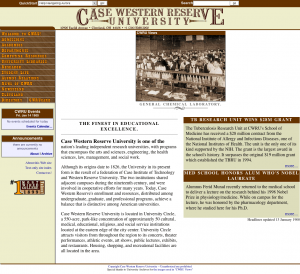
Then I reskinned the home page to look more “old-timey” without completely altering the layout or look. Instead of university-logo blues and gold, I recolored everything to be wood-grain. Helvetica was replaced with an “Old West” font in the images, of which there were several, mostly in the form of MM_swapimage-style rollover buttons. In the process, I actually had to introduce two Y2K bugs to the code we used to generate dates on the page, so that instead of saying 2000 they’d actually say 1899 or 1900. I altered other things to match the time, like altering the phone number to use two-letters-then-numbers format while still retaining full international dialing information and adding little curlicues to things. Well before the holidays, everything was ready.
The files were staged, a cron job was set up, and at midnight on January 1st, 2000, the home page seamlessly switched over to its 1900 incarnation. That’s a static snapshot of the page, so the picture will never change, but I have a gallery of all the pictures that could appear, along with their captions, which I strove to write in that deadpan stating-the-obvious tone the late 19th Century always brings to my mind. (And take a close look at the team photo of The Rough Riders!)
In hindsight, our mistake was most likely in adding a similarly deadpan note to the home page that read:
Year 2000 Issues
Despite our best efforts at averting Y2K problems, it seems that our Web server now believes that it is January of 1900. Please be advised that we are working diligently on the problem and hope to have it fixed soon.
I say that was a mistake because it was quoted verbatim in stories at Wired and The Washington Post about Y2K glitches. Where they said we’d actually suffered a real, unintentional Y2K bug, with Wired giving us points for having “guts” in publicly calling “a glitch a glitch”. After I emailed both reporters to explain the situation and point them to our press release about it, The Washington Post did publish a correction a few days later, buried in a bottom corner of page A16 or something like that. So far as I know, Wired never acknowledged the error.
CWRU2K lasted a little more than a day. Although we’d planned to leave it up until the end of January, we were ordered to take it down on January 2nd. My boss, Ron Ryan, was directed to put a note in my Permanent Record. The general attitude Ron conveyed to me was along the lines of, “The administration says it’s clever and all, but it’s time to go back to the regular home page. Next time, we need to ask permission rather than forgiveness.”
What we didn’t know at the time was how close he’d come to being fired. At Ron’s retirement party last year, the guy who was his boss on January 2nd, 2000, Jim Barker, told Ron that Jim had been summoned that day to a Vice President’s office, read the riot act, and was sent away with instructions to “fire Ron’s ass”. Fortunately, Jim… didn’t. And then kept it to himself for almost 20 years.
There were a number of other consequences. We got a quite a bit of email about it, some in on the joke, others taking it as seriously as Wired. There’s a particularly lovely note partway down that page from the widow of a Professor Emeritus, and have to admit that I still smile over the props we got from folks on the NANOG mailing list. I took an offer to join a startup a couple of months later, and while I was probably ready to move on in any case, the CWRU2K episode—or rather, the administration’s reaction to it—helped push me to make the jump. I was probably being a little juvenile and over-reacting, but I guess you do that when you’re younger. (And I probably would have left the next year regardless, when I got the offer to join Netscape as a Standards Evangelist. Actual job title!)
So, that’s the story of how Y2K affected me. There are some things I probably would have done differently if I had it to do over, but I’m 100% glad we did it.
Have something to say to all that? You can add a comment to the post, or email Eric directly.
groon groon, babey (tanner bananer)

"come get ur speed on with up to 4 friends and bounce and fly around the world of groon groon." - Author's description
Play / download on itch.io (Browser, Windows, Mac, Linux)
AI Dungeon 2 (Nick Walton)
Taylor SwiftSeriously, if you haven't played this yet then you should

"Imagine an infinitely generated world that you could explore endlessly, continually finding entirely new content and adventures." - Author's description
Play here (Browser)
Fast and Free Music Separation with Deezer’s Machine Learning Library
Cleanly isolating vocals from drums, bass, piano, and other musical accompaniment is the dream of every mashup artist, karaoke fan, and producer. Commercial solutions exist, but can be expensive and unreliable. Techniques like phase cancellation have very mixed results.
The engineering team behind streaming music service Deezer just open-sourced Spleeter, their audio separation library built on Python and TensorFlow that uses machine learning to quickly and freely separate music into stems. (Read more in today’s announcement.)
The team at @Deezer just released #Spleeter, a Python music source separation library with state-of-the-art pre-trained models!
—
Straight from command line, you can extract voice, piano, drums… from any music track! Uses @TensorFlow and #Keras.https://t.co/e4lyVtT2lR pic.twitter.com/tDsBMSYiJDDynamicWebPaige @ #TFWorld
(@DynamicWebPaige) November 2, 2019
You can train it yourself if you have the resources, but the three models they released already far surpass any available free tool that I know of, and rival commercial plugins and services. The library ships with three pre-trained models:
- Two stems – Vocals and Other Accompaniment
- Four stems – Vocals, Drums, Bass, Other
- Five stems – Vocals, Drums, Bass, Piano, Other
It took a couple minutes to install the library, which includes installing Conda, and processing audio was much faster than expected.
On my five-year-old MacBook Pro using the CPU only, Spleeter processed audio at a rate of about 5.5x faster than real-time for the simplest two-stem separation, or about one minute of processing time for every 5.5 minutes of audio. Five-stem separation took around three minutes for 5.5 minutes of audio.
When running on a GPU, the Deezer team report speeds 100x faster than real-time for four stems, converting 3.5 hours of music in less than 90 seconds on a single GeForce GTX 1080.
Sample Results
But how are the results? I tried a handful of tracks across multiple genres, and all performed incredibly well. Vocals sometimes get a robotic autotuned feel, but the amount of bleed is shockingly low relative to other solutions.
I ran several songs through the two-stem filter, which is the fastest and most useful. The 30-second samples are the separations from the simplest two-stem model, with links to the original studio tracks where available.
 Lizzo – “Truth Hurts”
Lizzo – “Truth Hurts”
Compare the above to the isolated vocals generated by PhonicMind, a commercial service that uses machine learning to separate audio, starting at $3.99 per song. The piano is audible throughout PhonicMind’s track.
 Led Zeppelin – “Whole Lotta Love”
Led Zeppelin – “Whole Lotta Love”
The original isolated vocals from the master tapes for comparison. Spleeter gets a bit confused with the background vocals, with the secondary slide guitar bleeding into the vocal track.
 Lil Nas X w/Billy Ray Cyrus – “Old Town Road (Remix)”
Lil Nas X w/Billy Ray Cyrus – “Old Town Road (Remix)”
Part of the beat makes it into Lil Nas X’s vocal track. No studio stems are available, but a fan used the Diplo remix to create this vocals-only track for comparison.
 Marvin Gaye – “I Heard It Through the Grapevine”
Marvin Gaye – “I Heard It Through the Grapevine”
Some of the background vocals get included in both tracks here, which is probably great for karaoke, but may not be ideal for remixing. Compare this to 1:10 in the studio vocals.
 Billie Eilish – “Bad Guy”
Billie Eilish – “Bad Guy”
I thought this one would be a disaster—the vocals are heavily processed and lower in the mix with a dynamic bass dominating the song—but it worked surprisingly well, though some of the snaps bleed through.
 Van Halen – “Runnin’ With The Devil”
Van Halen – “Runnin’ With The Devil”
Spleeter had a difficult time with this one, but still not bad. You can compare the results generated by Spleeter to the famously viral isolated vocals by David Lee Roth, dry with no vocal effects applied.
Open-Unmix
The release of Spleeter comes shortly after the release of Open-Unmix, another open-source separation library for Python that similarly uses deep neural networks with TensorFlow for source separation.
In my testing, Open-Unmix separated audio at about 35% of the speed of Spleeter, didn’t support MP3 files, and generated noticeably worse results. Compare the output from Open-Unmix below for Lizzo’s isolated vocals, with drums clearly audible once they kick in at the 0:18 mark.
The quality issues can likely be attributed to the model released with Open-Unmix, which was trained on a relatively small set of 150 songs available in the MUSDB18 dataset. The team behind Open Unmix is also working on “UMX PRO,” a more extensive model trained on a larger dataset, but it’s not publicly available for testing.
What Now?
Years ago, I made a goofy experiment called Waxymash, taking four random isolated music tracks off YouTube, and colliding them into the world’s worst mashup. But I was mostly limited to a small number of well-known songs that had their stems leak online, or the few that could be separated cleanly with channel manipulation.
With processing speeds at 100 times faster than real-time playback on a single GPU, it’s now possible to turn all recorded music into a mashup or karaoke without access to the source audio. It may not be legal, but it’s definitely possible.
What would you build with it? I’d love to hear your ideas.
Thanks to Paige for the initial tip!
Updates
This thing is dangerously fun.
nobody should have this kind of power pic.twitter.com/4vbl2MGK4Z
— Andy Baio (@waxpancake) November 5, 2019
November 11. You can now play with Spleeter entirely in the browser with Moises.ai, a free service by Geraldo Ramos. After uploading an MP3, it will email you a link to download the stems.
Also, the Deezer team made Spleeter available as a Jupyter notebook within Google Colab. In my testing, larger audio files won’t play directly within Colab, and will need to be downloaded first to listen to.
AI Dungeon 2
One-panel Friday
Taylor SwiftAlso it's not a tattoo if it's just painted onto your fur??????? What the hell
Family Circus, 11/22/19

OK, guys, look, as a childfree adult who spends very little time interacting with toddlers, I don’t have … the strongest sense of how big they are, and that’s on me. But I also think that some of the sizing of objects in the Family Circus is a little off, like things are the wrong size in comparison to one another, for whatever reason (whispers “clip art” into the wind). What I’m trying to say is, that’s an enormous bowl of gruel Ma Keane is holding, right? Like, it’s almost the size of Jeffy’s torso and it is filled to the brim with viscous, ecru flavor. It’s gotta be really heavy and honestly Jeffy is lucky he’s getting as much hug as he’s getting.
Mother Goose and Grimm, 11/22/19
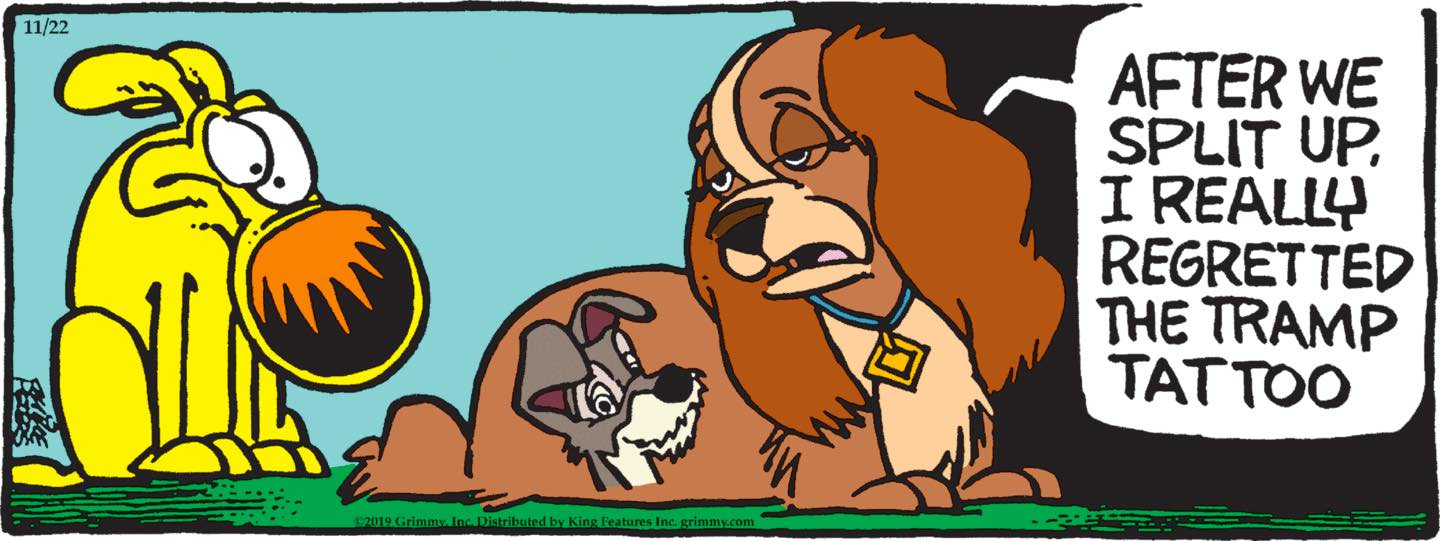
IT’S CALLED A “TRAMP STAMP”
NOBODY CALLS IT A “TRAMP TATTOO”
THE JOKE DOESN’T WORK AT ALL UNLESS YOU CALL IT A “TRAMP STAMP”
ALSO IT’S ON THE LOWER BACK, BECAUSE THE IMPLICATION IS THAT IT’S FOR PEOPLE TO LOOK AT WHILE YOU DO IT “DOGGY STYLE”
YOU DON’T GET TO DO THIS JOKE UNLESS YOU FOLLOW ITS IMPLICATIONS TO THEIR LOGICAL CONCLUSIONS
I DON’T MAKE THE RULES
Black Dawn Rebirth (Amiga) – Try Before You Buy – Demo Available
Can’t believe Wilbur’s not using his shower radio for this
Taylor SwiftMary Worth is POPPING the FUCK OFF right now
Judge Parker, 11/20/19

Hey guys, remember Honey Ballinger? Remember how Sophie coveted her boyfriend Derek and then plotted to steal away her boyfriend? Remember how Sophie later got mad that Honey was going steal away Sophie’s boyfriend, Derek? And then, uh, there was the whole confusing car crash/kidnapping plot where Honey got away but Sophie was kidnapped, for a while? Remember how Sam and Sophie’s dad teamed up to track down the kidnapper, super-incompetently? Well, Judge Parker remembers, and is here to remind you that material consequences still remain things suffered by non-Parker-Spencer-Drivers, as Sam, an insanely wealthy man who has apparently decided to restart his law practice on a whim and was shopping around for pricey office real estate last week while his erstwhile partner in vigilantism cashes unemployment checks somewhere, can attest.
Blondie, 11/20/19

I have to admit that I don’t actually get the joke here or the transition between the two panels, unless Lou is saying that so-called “secret menus” (In-N-Out Burger’s is probably the most famous) are essentially marketing devices designed to build word-of-mouth buzz and drive in more customers, whereas Lou’s Diner, quite obviously, has a number of operational problems and can barely handle the customers it has.
Mary Worth, 11/20/19

I swear to God that when I wrote the title for yesterday’s post I had no idea what joys today’s Mary Worth would bring. Now, you might find Wilbur’s song choice wildly inappropriate, as the complex narrative of “Escape (The Piña Colada Song)” — in which the narrator seeks to cheat on his “lady” by answering a personal ad, only to discover that the ad was placed by her, looking to cheat on him — doesn’t really map onto his and Estelle’s relationship at all. But beyond the specific details of the story, the song’s core message — that the relationship you’re in now might seem unpleasant, like a literal prison, but honestly, if you go looking for something better you won’t find it, so you might as well stick with it — is probably the most convincing argument he could make in his favor at this point. Anyway, I stand by what I said yesterday: Estelle should definitely, definitely call the cops.
Star Vagrant – A new space trading game for the Atari XL/XE
Taylor SwiftOf all the new-software-for-old-microcomputer posts I've ever read this one made me go Whoa the loudest.
Comme Des Garcons Japanese Street Style in Harajuku w/ Headpiece, Rabbit Bag, Balloon Pants & CDG x Dr. Martens
Haruno is an 18-year-old Japanese student who easily caught our eye on the street in Harajuku.
Haruno is a fan of Japanese designer Rei Kawakubo and her look features a striking Comme Des Garcons headpiece with a white button up Comme Des Garcons shirt, Comme Des Garcons balloon suspender pants, and Comme Des Garcons x Dr. Martens shoes. Her rabbit shaped bag is by Comme Des Garcons Girl.
Not surprisingly, Haruno’s favorite fashion brand is Comme Des Garcons. Check out her Instagram for more avantgarde fashion.





Click on any photo to enlarge it.
Soggy Landing – Chapter 1 – by Ian Densford and the Brothers McGovern
A traveling wizard joins a rebellion on the island town of Soggy Landing, a city-state controlled by a corrupt government and allied businesses. by Ian Densford and the Brothers McGovern. Soggy Landing updates every Tuesday and Friday.
– READ PREVIOUS INSTALLMENT –
– READ NEWEST UPDATE –


– TO BE CONTINUED – SOGGY LANDING UPDATES TUESDAYS AND FRIDAYS –
The post Soggy Landing - Chapter 1 - by Ian Densford and the Brothers McGovern first appeared on Study Group Comic Books.
1945
Taylor SwiftThis is a little intense for 9 AM, sorry about that.
Transcript of Surreptitiously Taped Conversations among German Nuclear Physicists Learning America had Dropped an Atomic Bomb on Hiroshima
All the guests assembled to hear the official announcement at 9 o'clock. They were completely stunned when they realized that the news was genuine. They were left alone on the assumption that they would discuss the position and the following remarks were made.:–
HARTECK: They have managed it either with mass-spectrographs on a large scale or else they have been successful with a photo-chemical process.
WIRTZ: Well I would say photo-chemistry or diffusion. Ordinary diffusion. They irradiate it with a particular wave-length. – (all talking together).
HARTECK: Or using mass-spectrographs in enormous quantities. It is perhaps possible for a mass-spectrograph to make one milligram in one day – say of '235'. They could make quite a cheap mass-spectrograph which, in very large quantities, might cost a hundred dollars. You could do it with a hundred thousand mass-spectrographs.
HEISENBERG: Yes, of course, if you do it like that; and they seem to have worked on that scale. 180,000 people were working on it.
HARTECK: Which is a hundred times more than we had.
HEISENBERG: We wouldn't have had the moral courage to recommend to the Government in the spring of 1942 that they should employ 120,000 men just for building the thing up.
WEIZSÄCKER: I believe the reason we didn't do it was because all the physicists didn't want to do it, on principle. If we had all wanted Germany to win the war we would have succeeded.
HAHN: I don't believe that but I am thankful we didn't succeed.
HEISENBERG: It is possible that the war will be over tomorrow.
HARTECK: The following day we will go home.
KORSHING: We will never go home again.
KORSHING: If one hasn't got the courage, it is better to give up straightaway.
GERLACH: Don't always make such aggressive remarks.
KORSHING: The Americans could do it better than we could, that's clear.
(GERLACH leaves the room.)
WEIZSÄCKER: I admit that after this business I am more ready to go back to GERMANY, in spite of the Russian advance.
WIRTZ: My worst fears have been realized with regard to the complications which will now arise about us.
HEISENBERG: I believe that we are now far more bound up with the Anglo–Saxons than we were before as we have no possibility of switching over to the Russians even if we wanted to.
WIRTZ: They won't let us.
HEISENBERG: On the other hand we can do it with a good conscience because we can see that in the immediate future GERMANY will be under Anglo–Saxon influence.
WIRTZ: That is an opportunist attitude.
HEISENBERG: But at the moment it is very difficult to think otherwise because one does not know what is better.
Although the guests retired to bed about 1.30, most of them appear to have spent a somewhat disturbed night judging by the deep sighs and occasional shouts which were 12 heard during the night. There was also a considerable amount of coming and going along the corridors.
Graydon Hoare

Who are you, and what do you do?
My name is Graydon Hoare, I'm a middle-aged socialist boring cishet white guy who lives in Vancouver, Canada. My favourite passtime is taking long walks by the ocean, which I live next to. I also enjoy napping, reading history books, hanging out with friends, and watching the same dozen bad 80s movies over and over. I have a passion for public infrastructure investment and paying maintenance and care workers adequately.
Assuming this is more about work though: I work on software professionally and often as a hobby. My work is usually developer tools -- compilers, profilers, debugging tools -- or distributed systems of some sort. I've worked for Red Hat, Mozilla, Apple, Stellar, and a few other places. Probably I'm being interviewed here because I started the Rust programming language project while at Mozilla.
What hardware do you use?
Older machines, maxed out in core count and RAM, and with NVMe storage. We haven't seen a ton of machine improvement in the past decade so I aim for reliable workhorses a ways down the cost-depreciation curve. Quite a few machines unfortunately: separate work and personal, separate Windows/Linux/Mac, plus some stockpiling of machines from good but discontinued production runs. The i7 MacBook Airs from 2013 and 2015. Some iPhone SEs. A couple Linux/Windows workstations built from refurb dual-socket 2013 Xeon server parts, each 40-way parallel with 128GB RAM, sufficient for any heavier lifting I need. I still have a couple ThinkPads kicking around -- a 32GB W530 and an older X61 -- they still work, they're nigh-indestructible.
I bought a comedically huge 42 inch LG monitor recently, because they got too cheap to refuse. Thankfully I don't play games, so no gaming hardware. I do have a QNAP NAS for local file service, movies and music, but I foolishly bought one with too little RAM so to keep it from paging I have it reboot itself every 24 hours. This is the software world we live in.
And what software?
Emacs for editing, which is about half my day. Often using one of the faster workstations remotely for building and navigation. Editing is accompanied by a lot of command-line tools and the occasional GUI tool: compilers (clang, swiftc, rustc, go, fsc, ocamlc), debuggers (lldb and gdb), profilers (perf, Instruments, heaptrack), scripting (make, Bash, Python), diagramming (Monodraw and OmniGraffle) and navigation (RTags and Sourcetrail). Many days I'll use one or more developer tools I've also contributed to at some point in the past, which has both a sort of family comfort feeling and also a worrying feeling like "oh no how can software be such a mess that this is the best option?"
I work remotely and much of my work is communicating, planning, review, discussion; so I use every chat and video conferencing program under the sun. My heart is probably in irc and trn but I regularly use Gmail, Slack, Meet, FaceTime, Skype, Signal, Keybase, Messages, etc. All this of course runs in a web browser, but I'm not religious about which. Firefox is better in a privacy and politics sense; but a lot of sites are getting to be Chrome-specific, so I use what I have to.
One ridiculous peculiarity of my software preferences is I like editing in low-res bitmap fonts with pixel-y edges, no antialiasing, visible scanlines. I guess it's a nostalgia thing: I grew up in the 80s and "it looks right". I have to fight the software a lot to get this working and it gets harder every year. Currently I'm using one called ctrld which is a derivative of Dina and my previous favourite family, Proggy. There are a few die-hards who collect and maintain these things, to whom I'm very grateful.
What would be your dream setup?
The hardware's probably already past as good as it's going to get, and is into pointless frills and planned obsolescence. See above: I literally prefer stuff that's already discontinued.
Nostalgia-wise I'd probably like to be spending my days in front of an amber VT320 -- ah, soothing text -- but I think they cause radiation sickness and are neither portable nor battery powered, and anyways we need to use the web these days. I don't especially like the web and I dream of a different world where we built a different information infrastructure.
Software-wise I really wish we'd done almost everything differently. The focus has been on eyeballs and engagement, not like "does it work" or "can it resist attack by a bad actor". Almost no modern software works well or is safe in any serious sense. It's always on fire. A sinking ship with everyone frantically bailing. Swiss cheese. Pick your metaphor. So my dream setup would involve "software that has any sort of reliability". Which probably requires rewinding time to before the personal computing era and enacting liability legislation or something.
I hope you enjoyed the interview! Did you know you can sponsor the site on Patreon? You'd have a hand in guiding the site's future, and help support independent publishing!
Thoughts on the Glorantha Sourcebook
LAYOUT AND ART
My favourite thing about this book and most powerful sensory experience is the quality, variety and integration of the art throughout the whole of the book.There are some minor quibbles with the dietetic elements. I fantasise about an epistolary world and
this attempt is imperfect, but still noble and good.
Firstly, this book is BRIGHT, which I very much appreciate and which fits the tone and feel of the world it describes.
As someone who has been quietly disappointed in Games Workshops slowly dulling aesthetic and not really happy with its art or the way it integrates image, world-building, infographics and DIFFERING STYLES of art within the same world window;
THIS IS HOW YOU FUCKING DO THAT.
THE DIVINE INFOGRAPHICS
My favourite part of the book is these repeated family trees of the divine hierarchies for the different cultures and celestial courts. Since the superstructure of Glorantha is all about divine powers, these are essentially cosmic maps of the setting.
They are tremendous fun, and very well made. They also feel 'real' or sub-real, they have a pleasing harmony of pseudosense
THE INTEGRATION OF STYLES
There are many different artists throughout the whole of the book but the sense of them as a whole, as representing the same reality, though seen through different eyes, is sustained throughout.
This feels more like the kind of book where the artists have been allowed to draw the bits they find most interesting and then space has been found for it, rather than the other way round.
The fact that there is no absolute, crushing 'Gloranthan House-Style' means it feels like the art as a whole, across the book, can breathe. There is a pleasing range of variety of methods and approaches within a loose but cohesive whole.
This fudges the diegesis somewhat. Some elements, like the bas-reliefs at the start of the book,
or this vase on page 160,
seem highly diegetic, as if they are literal artefacts which have been transcribed directly onto the page from the imagined world.
Other pieces have an un-specific diegesis, pictures from inside the world, but with no particular named artist or exact in-world point of view.
We could regard this as imperfect in the abstract but in function, as the book is read, it works fine. The human mind can deal quite easily with this mixture of levels of diegetic and less-diegetic elements, as we do when we are children, and the concept of the book never leans on that structure so heavily that the differences become a problem.
Simply - these images speak in different voices, but they all feel like they are talking about the same thing.
THE TEXT - THE AMERICANNESS OF GLORANTHA
In both its world-concept and in its writing style, Glorantha feels to me, really intensely American.This might not make sense initially as, in its subject and its openness to influence, I think it draws hugely from a staggering range of real-world religions and cultures. There is a shitload of Hinduism in there for a start, but there is a lot of Everything in there.
I'll begin with the language
This is really hard to define, and none of it is intended as a criticism. There is a quality here I think of as 'plains English', which, by imagination or not I tend to associate with the middle bits of America. Friendly bearded protestant men with Hawaiian t-shirts and Tiki collections who go to church every Sunday. People who's grandfathers probably spoke German or Dutch.
"Then a great dark spot rose into the sky upon the net. This huge bloated shadow flickered with a smoky glow. The shadow crept across the face of the sun, blotting it out and making all the world cold for a moment. A snapping moment of terror pierced the world, then the dark sky-web vanished, and the edge of the sun crept past the shadow. The shadow disappeared and the sun brightened, but everyone thought it looked paler than it had before. Some said it moved differently, too.
In Pamaltela, the heat strengthened the many spirits of that realm. They entered the jungles, plants, and elves, and combated the rot in their fibers."
There is certainly nothing wrong with this and it does its work. There is something in it that reminds me of American ticker-tape just-the-facts prose. Americans, I believe, do not like compressions of meaning, or elisions. They like a word to be a word and a phrase to be clear, to be linked directly to the next phase and for its meaning to be what it plainly signifies itself to be. They also seem to dislike strong euphony and intensification of rhythm. There is a Germanic tendency there that its better to extend a sentence than to potentially leave any element of it open to inconstant interpretation. Brandon Sanderson is a bit like this in some of his things I've read. It is very clear, democratic, rather Methodist-bible language.
Theogony Gumbo
The simple fact that Glorantha takes from so many different world religions and the combination of its very open-hearted and very open-handed attitude to them, along with the simultaneous access of knowledge and systemisation of that knowledge, speaks itself, in the nature of the intellectual work done, of a particular time and place.
This kind of mingling together of influences would not have happened in this way at many other times.
A little earlier in Anglo-diaspora history the 'foreign' bits would probably be more foreign, more orientalised. A lot earlier and the knowledge either wouldn't exist or the originating religion/cultures that make it up either wouldn't be in conversation with each other or wouldn't get on.
Post 2000's, I think most millennials would probably feel bad about taking aspects of IRL cultures and religions from different real-world ethnicities and just jamming them together anyhow. It seems like the kind of thing someone would get upset about.
So this reads to me as very much a product of the 1960-1990-s era of relative liberalism. And the willingness to systematise the whole thing (though the diegetic elements of the world itself do remark that there is no absolute systemisation of divine order from within the world, only differing interpretations arranged around a wide but fuzzy 'general knowledge).
This is from what I think of a "Cultural Lego Times". Innocent times when a bunch of nerds could just reach out to grab elements of different cultures and fantasy elements and just jam them together like a child making something, without a great deal of angst or drama.
I do not think we live in Cultural Lego Times any more.
The Fantasy Elements
Glorantha has humanoid Ducks in it. Literally they are only in a few pages BUT THEY ARE ON THE COVER AND THEY ARE CANON. So, this is the kind of highly developed fantasy world where it has its own divine hierarchies but clearly at some point Sandy Petersens best friend or someone really wanted to play a humanoid duck, and while they haven't really gone deep on the duck thing since then, they are still in there.
My broad point here is that the genesis of the integration of fantasy elements, with trolls (but different), elves, dwarfs etc (but different) and not hobbits (but we have ducks), again seems to me to come from a particular time and place. The post-Tolkien 60's-70's boom. (Much of Glorantha feels very 70s to me). It has that slightly gauche summery tactile 70's vibe.
On the mid-20thC Paracosm-boom scale, it’s very clearly cooler and edgier than Greyhawk or Blackmoor, and more coherent than Coventry, but not quite as cool as Tekumel, which is like Gloranthas edgy brother who plays in a band and won't let Glorantha into their room.
So all of this makes me intuit that, though Glorantha is, very nobly, a combination of a vast range of influences and has many highly original elements and aspects, the range and origins of those sources, and the manner of their integration and expression, make it feel very American to me.
GODS IN GLORANTHA
If this is about anything it’s about the integration of a coherent Theogony as a magical, moral, cosmic, historic and philosophical superstructure for a fantasy world. If you want to play a game where there are lots of religions and where religion matters then this is for you.
Gods in Glorantha play a dozen roles.
Gods as Aircraft Carriers.
Their simplest is as tanks or artillery divisions in battles. Every culture has a god or godsquad and when they come into military conflict whoever has the strongest god(s) and can get them to intervene more effectually will win battles by having them lend power or simply turn up on the field.
So Gloranthan military engagements are actually 5th dimensional affairs in which ritual and spiritual elements can transform into simple military materiel and visa-versa (a little like 40k).
Gods as Culture-Leaders
Gods incarnate, visitate and reincarnate a whole bunch and this can lead the centre of any culture an effectively-immortal warrior/teacher/prophet/lawgiver who acts not only as a private superman but also as a kind of cultural and moral library and judge.
It’s a little like the British Sovereign is almost meant to be in law, a magical source of power, and a little like if George Washington could reincarnate on each death, but with all knowledge intact, and if all George Washingtons children might be born with a few grammes of divine Washington power. And if you want to invade America successfully, you need to find and permanently kill the reincarnating George Washingon, but once you do that, the rest of the place goes down pretty easy.
Or simply as if all that Eurasian stuff about bronze-age God-Kings was pretty much accurate and literally true.
Gods as Magical and Philosophical Superstrucure Soap-Opera
Since the gods are definitely real, though mainly outside time, and since there is a big library of gods and their exact relations and histories, learning magic, philosophy and history is really learning about this big divine Soap-Opera and trying to get close to, and understand, one or more of the characters.
Magical and divine power in Glorantha is so integrated, and so total, trying to understand it is one of the few useful things you can do. Societies and cultures that gain technological or philosophical dominance, don't do it necessarily by prioritising technology and science, but by getting close to a highly rationalist god or god-philosophy that releases these capacities in them.
God as Atom Bombs
You can basically smash any problem if you can get a big enough god on it.
There seems to be a theme in Glorantaha of Godwars and gods punching each other to pieces leaving holes or damaging reality so that the grainy sinister 90's CGI of Chaos can come through. Since its a D&D world where becoming a demigod is the last rung of promotion and since its quite and agonistic world where adventure needs to happen, this adds an element of tragedy; your super-adventure might end up punching a hole in the Real and bringing Glorantha closer to DOOM.
QUESTIONS
FOR PEOPLE WHO PLAY IN GLORANTHA
How the fuck do you play in Glorantha?
I'm waaaay into Warhammer 40k, to the extent that I have opinions on the different _voice actors_ for the Audiobook Readers in the Horus Heresy series.
Reading this Glorantha sourcebook is probably as close as I can get to what it must be like to be introduced to 40k for the first time. Holy crap this is a fucktonne of stuff to be slammed over the head with.
Even as someone who is generally into pseudohistories, and this being, essentially, part of my job, bit parts of Glorantha were a real slog to get through. There is just a huge, HUGE amount of highly specific history here. Staggering levels of detail, highly specific and, due to Gloranthas close integration of divine order, magical power and temporal culture, highly consequential information.
I know there are a huge amount of playstyles and cognitive/world-engine preferences out there very different to mine and this is probably exactly what a bunch of you are specifically looking for.
People who play in Glorantha, specifically, people who are introducing new players into Glorantha. How do you do it? Is it a loremaster thing where the DM is just deeply read in the pseudohistory and drops it on the unknowing as things go on? Do you need a bunch of experts on Glortantha to play?
From my personal biases, Glorantha is so dense that its virtually unplayable as a game setting, but I know most are not like me, so what are you doing?
Where did Glorantha Come From?
I know there must be a forum somewhere purely about this, and with its own scandals and schisms, are we at the point yet where anyone can summarise 40+ years of paracosm development in a blog comment or medium article? Probably not.
How much of the legendary background is stuff that happened in some game back in the 70's? Or in some wargame? Very large amounts of this read like legendarification of someones play reports, specifically the oddness of the pseudohistories which come off very much like some player-character stuff.
Or am I wrong and its all designed-in? Or did it evolve over multiple books over different eras? Has anyone written the historiography of the creation of Glorantha? And then helpfully done the condensed version because I probably don't have time to read the whole thing.
THE COMMENTS ON THIS ARE REALLY INTERESTING IF YOU WANT TO SEE TRENT DO A DEEP-DIVE ON GLORANTHA AND A BUNCH OF OTHER STUFF
Handmade Japanese Streetwear in Harajuku w/ Ash Grey Hair, Layered Tops, Handmade Cutout Jeans w/ Rainbow Straps, Kawi Jamele & Bershka
Sporting an eye-catching ensemble on the Harajuku street is Zaki, a 19-year-old fashion college student with ash grey hair.
He stepped out in a black pinstripe blazer, worn over a black long sleeve fishnet top and layered with a black leather zip-up cropped top with rhinestone embellishments. Zaki paired his tops with handmade denim pants, which feature front leg cutouts with rainbow belt detailing. He stepped into a pair of blue crocodile leather lace-up heeled boots from Bershka and accessorized with Kawi Jamele items such as black visor sunglasses, silver hoop earrings, a silver moon necklace layered with a chain necklace, a white grommet belt, and multiple silver rings. In addition, Zaki is carrying a Louis Vuitton purse hanging from his belt loop.
Zaki loves listening to music by Lady Gaga. You can follow him on Instagram for more of his custom street fashion.









Click on any photo to enlarge it.
Kawaii Alien Street Styles w/ Gameboy, Mario Bros, M&Ms, 6%DOKIDOKI, Mickey Mouse & Tokyo Bopper Sneakers
Easily catching our eye on the street in Harajuku are two young aliens – Toyboy Daigo, 5, from Mercury and Gameboy Shinji 7, from Venus – dressed in kawaii fun fashion.
At the left we have Gameboy Shinji, a 7-year-old Kinji staffer with yellow hair. He is clad in a white Gameboy print t-shirt and a pair of stars and stripes printed shorts, both of which are from WEGO vintage. White knee socks with Gameboy print, red-and-white Tokyo Bopper sneakers, and a yellow backpack, which is a magazine free gift. Accessories such as a USA cap from Anpontan, Mario Bros earrings, a rainbow pixel bead necklace from Yoshida Beads, yellow checkered sunglasses, Nintendo game controllers around his neck, a Nintendo gameboy watch, cute yellow bangles, and cute Mario franchise knuckleduster rings from Gachapon . Shinji is also carrying a Mario toy. Shinji lists San To Nibun No Ichi, Anpontan and Shinji as his fashion favorites, and he is active on Twitter and Instagram.
Meanwhile, Toyboy Daigo stepped out in a blue M&M’s t-shirt from Kinji, a checkered button down shirt, and blue shorts with checkered side trims from Lifeline Kinji. Red-and-blue striped Superman socks, blue-and-white Tokyo Bopper sneakers, and a Disney Mickey Mouse plushie bag completed his outfit. He also wore a Mickey Mouse hat perched on top of his blue hair, and embellished his look with accessories such as blue pixel bead flame earrings, a red chain necklace with Ressha Sentai Toqger toys, a black waist bag attached to his belt, blue sunglasses, a red-and-white checkered arm band, a strapped toy arm piece, and 6%DokiDoki rings. The 5-year-old Super Neet staffer’s favorite brands are Anpontan, Kinji and Honwakapappa, and he enjoys music from Japanese girl idol group, Shiritsu Ebisu Chugaku. Toyboy Daigo is also active on Twitter and Instagram.

























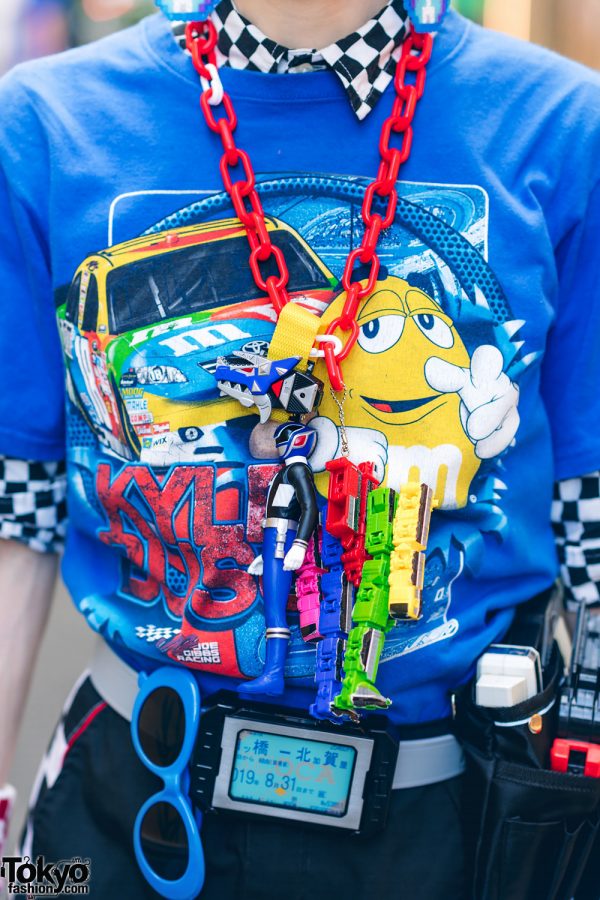





Click on any photo to enlarge it.
Harajuku Girl Wearing Pastel Bonanza Satrangi Top, Khaadi Bottoms & Accessories From Pakistan
Taylor SwiftFuck yeah!!!!
Sanaa is a 20-year-old game design student from the UK who we have been seeing around Harajuku recently. This time, we street snapped her on Eid.
Sanaa’s pastel look includes a pastel top by Bonanza Satrangi with Khaadi bottoms and accessories from “somewhere in Pakistan”.
Sanaa’s favorite shops/brands include Kinji Harajuku and Zara Shahjahan. Her favorite bands include No Buses, Tomato Ketchup Boys, and Shame. Follow Sanaa on Twitter or Instagram.




Click on any photo to enlarge it.
